More Defunct Habsburgs
Austria and Slovakia, July 25-29
Crossing the Brenner Pass once again, we headed for Weer, a village located a few kilometers east of Innsbruck. We had made reservations at the Weererwirt, a large inn that attracted many German and Swiss families with small children, whom we joined at the swimming pool to escape the heat. The inn itself could not have been more charming with folk art like the angel (mermaid?) chandeliers in the dining room.
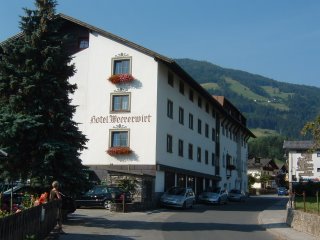
Weererwirt Hotel, Weer

Chandelier at Hotel Weererwirt
Disciplined as we are, we spent most of Wednesday sightseeing in a sweltering Innsbruck, the favorite locale of Emperor Maximilian I (Charles V’s grandfather and predecessor), who loved the city so much that he arranged to be buried there in a fantastic 16th Century tomb surrounded by statues of his predeceased relatives and other royal worthies. The imperial residence was subsequently redone in Baroque style by Empress Maria Theresa, who filled it with paintings of her progeny and their spouses. All this, plus the famous Goldenes Dachl, the city’s landmark, makes Innsbruck one of the jewels of Europe.
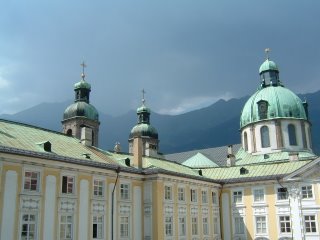
Hofburg, Innsbruck
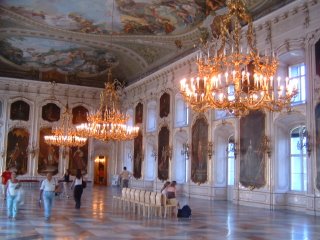
Giants' Hall, Hofburg, Innsbruck
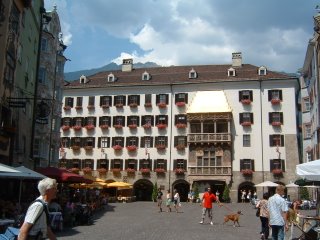
Goldenes Dachl, Innsbruck
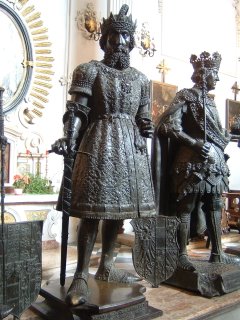
Maximilian's tomb, Innsbruck Hofkirche
We drove the next day to Vienna, but via Kitzbuehl to look at Sun Valley’s competition in Europe—“nice town, low mountains” is our capsule review. In Vienna Todd had meetings at the Secretariat of the Organization for Security and Cooperation in Europe and the US Mission to the OSCE to discuss the Transnistrian problem in Moldova, While Todd sat in air-conditioned offices, Georgia trod the burning pavements, visiting first the Secession Building, the Jugendstil showcase that features Gustav Klimt’s Beethoven Frieze, and then the Hofburg where she made three stops (the Prunksaal, the showpiece of the Austrian National Library; the Schatzkammer whose jewels she never resists when in Vienna; and the Augustinerkirche where silver urns in the Loreto Chapel contain the hearts of the Habsburg family). We rendezvoused at the end of the day, however, to tour the Hofburg exhibit commemorating Mozart’s 250th birthday, a wonderful kaleidoscope that merited far more than the 90 minutes we could devote to it.

Secession Building, Vienna
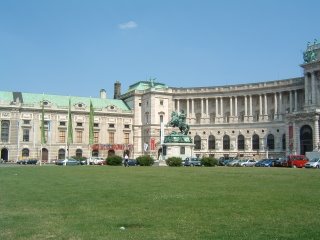
Hofburg, Vienna
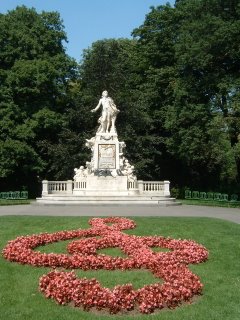
W. A. Mozart, Vienna
On Saturday we visited Bratislava, only an hour’s drive from Vienna, to see how the city had developed following the end of communism and the independence of Slovakia. The results impressed us favorably, for the Slovaks have turned the center of their capital into a pedestrian zone and refurbished the historic buildings there in a very attractive manner. Two good examples are the city hall and the Cathedral of St. Martin, the coronation place of many Hungarian kings, which boasts wonderful carvings in the choir. The old city does not lack humor, however, as evidenced by the many street sculptures (one of which was aped by a street mime) and the decision to place center court for the European U-18 beach volleyball tournament in the middle of Bratislava’s most prestigious square.

City hall, Bratislava
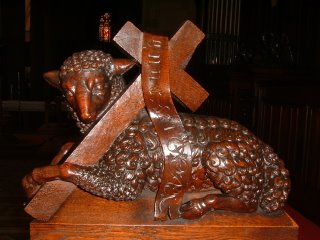
Choir stall carving in Bratislava Cathedral
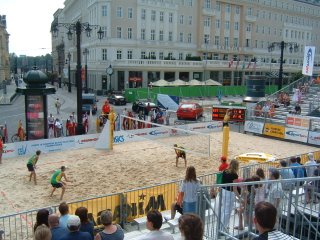
European U-18 Beach Volleyball Championship, Bratislava
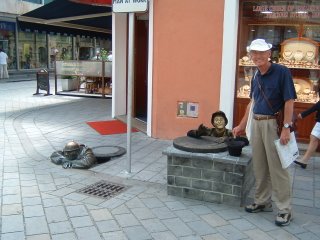
With street artist and statue, Bratislava
We closed out our Vienna experience with a visit to Beatrix Nohl, Todd’s partner in observing the Moldovan parliamentary elections last year, and her companion Damien Lahoupe, followed by dinner at a downtown sidewalk café where a rainstorm chased us inside. After two weeks of heat, we didn’t mind a bit.
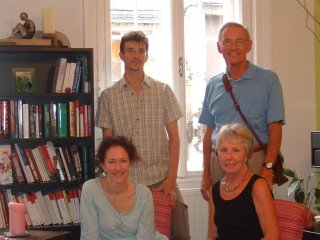
With Bea and Damien

0 Comments:
Post a Comment
<< Home